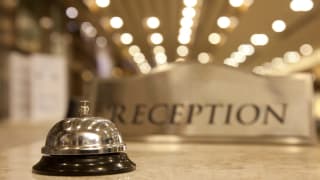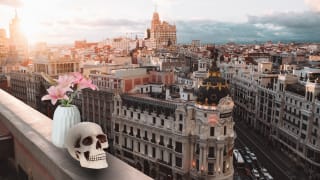‘Hear, here’: the sound of place branding and marketing
Even with travel suspended, destinations around the world were creating innovative campaigns to maintain their voice in the market and inspire future travel. We were privileged to see some of the best place marketing campaigns that the world had to offer at our City Nation Place Awards this November. But one thing was particularly noticeable to our jurors. Many of the campaigns sounded the same.
“Sound design has the power to skyrocket or plunge any decent place marketing script,” explained Daniel Valverde, County Brand Director for essential Costa Rica, and one of our 2020 jurors. “Places have the ability to entice all senses, so none should be taken for granted for such campaigns.”
It got us thinking. If places – particularly during lockdown – need to transport a person from their homes to a far-off location, then what role does sound play in recreating the experience of another location? How are places leveraging the uniqueness of their soundscapes to drive their place marketing and place branding?
Re-thinking the sound in your place marketing
When it comes to expressing your sound in place marketing, music is an obvious starting point, and it would be remiss of us not to share two of our favourites. Iceland’s Hardest Karaoke Song in the World, and Mount Pearl’s Anthem:
Mount Pearl’s Anthem in particular is brimming with community spirit and catapulted a small American town into international media attention. Of course, if everyone created their own anthems, we’d invariably end up in a position where many places are starting to ‘sound’ the same again. So how else can you dig into your cultural assets to create a unique sound in your marketing?
With the pandemic, the need to virtually transport people with your marketing has become more pressing, and several places have leveraged sound for that purpose. I Amsterdam recently launched a 3D audio tour to that very effect. Pro-tip – make sure you have headphones on and close your eyes for the full experience!
The soundscape uses the everyday hustle and bustle to transport you from your couch to the streets of Amsterdam – and stands out from the crowd with its creative approach. Similarly, Puerto Rico have delved into the history of their language and culture. A series of video tours help share the sounds of their country and encourage people to engage with Puerto Rico beyond their beautiful beaches.
And finally, Wesgro wowed our jurors this year with a podcast series, ‘Dreaming of One Day in the Western Cape.’ The series collated dream-inducing podcasts of whales in Gansbaai or sipping tea in the historic Bo-Kaap, to help lull prospective visitors to sleep. The ‘dreaming of one day’ concept was beautifully bought to life and created a new way for people to engage with the region from their own homes.
Whether through anthem, soundscape, or linguistical exploration, all these places have created multi-sensory experiences which share an authentic aspect of the destination. And in doing so, they create an emotional touch point with prospective travellers.
Building a place brand strategy around sound
The examples so far have looked solely at place marketing, and – as with everything – building a place brand to engage with citizens, visitors, and potential investors around sound is significantly more challenging. The obvious place to start, is with those places who are seen as intrinsically linked with a particular music culture. There aren’t many places who have successfully built their place brand around their musical identity, but those who have done it, have done it well. Think of the Jazz scene in New Orleans, the Techno nightlife in Berlin, Rio de Janeiro’s Samba Carnival.
However, that’s not to say that places with less obvious links to music aren’t able to build a place brand around sound. Take Struer, a small town in Denmark and home to the Bang & Olufsen HQ, a high-end manufacturer of audio products. With the number of jobs declining and civic pride evaporating, the ‘City of Sound’ strategy was born to help the city recover from the impact of the 2008 economic crisis on B&O.
“You might ask, why choose sound, when you’re dealing with a company that is actually struggling?” asked Peter Kjeldberg, Head of the City of Sound project, at the 2019 Global conference. “But sound is really in our DNA.”
Building on the history of sound invention and audio start-ups, the town has integrated new ways to experience sound throughout the city and positioned themselves as a hub for audio innovation. A number of interactive art exhibits make the ‘City of Sound’ an interactive experience, while events like ‘Run to the Beat’ or ‘Struer Tracks,’ a festival for Urban Sound Art, make experiencing sound in new ways an integral part to everyday life. And finally, Sound Hub Denmark opened its doors with an accelerator programme for start-ups in audio tech.
“A ‘sound manual’ has been approved by the city council,” Peter explained. “The sound manual is not only about sound attractions, but also presents a lot of guidelines on how to think sound into the planning phase as well.”
Collaboration is king
Jason Thorne, General Manager for Planning & Economic Development in Hamilton, Ontario, expressed a similar view at the 2019 Americas conference: “Let’s not just say we’re a music city and put out a t-shirt and hope that everyone believes it. Let’s actually do it, and actually be it.”
As with all place branding strategies, putting music at the heart of your brand has to be deeply embedded in all areas to be authentic. Hamilton changed zoning by-laws to allow live music on outside patios. They bought in planning policy to protect their music venues. Entrepreneur workshops were started to help musicians increase their business skills. They bought in major events, with stages for local music performances.
The challenge, of course, is not in finding these ideas – or even funding them – but in the collaboration between the teams needed to make it happen. In just the four previous examples, it was necessary for By-Law enforcement, and teams responsible for city planning, for culture, and for tourism to align. But by getting those little things right, you can create a really authentic place identity.
Preparing for recovery
As places begin to recover, the competition for travel, for investment, for talent could be intense. Being bold and innovative can be seen as risky – it can be hard to push the boundaries and take a risk on something that might not appeal to your audience. And for many places, becoming a music city won’t make sense for their everyday realities.
But when every second of attention counts, standing out from the crowd with your sound could make all the difference.
Related reading
The unsung benefits of attracting international students to your destination
COVID-19 - the sequel: the communication implications for destination marketing
Exploring tourism taxation as a method to fund a regenerative future
Hall of Fame: 15 of the best place marketing and place branding campaigns









